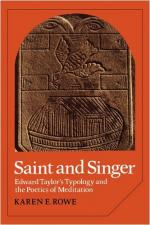|
This section contains 8,023 words (approx. 27 pages at 300 words per page) |

|
SOURCE: Rainwater, Catherine. “‘This Brazen Serpent Is a Doctors Shop’: Edward Taylor's Medical Vision.” In American Literature and Science, edited by Robert J. Scholnick, pp. 18-38. Lexington, Ky.: University Press of Kentucky, 1992.
In the following excerpt, originally published in 1991, Rainwater explores Taylor's dual role as religious poet and physician, tracing his attempts to reconcile emerging scientific developments with Puritan theology.
“A physitian cureth not only the body but the mind in some manner,” writes Nicholas Culpeper in 1654; his statement reflects the neo-Platonic and alchemical assumptions underlying Renaissance medical theory.1 Such holistic views of medicine prevailed in Edward Taylor's era (c. 1641-1729), despite the fact that the late seventeenth century was rapidly shifting away from an animistic cosmology, which stressed vital connections between matter and spirit, toward a Cartesian and mechanistic view, which posed few links between matter and spirit. Culpeper's and other hermetically based herbals were the primary...
|
This section contains 8,023 words (approx. 27 pages at 300 words per page) |

|


